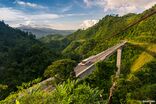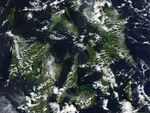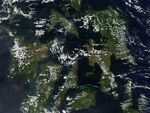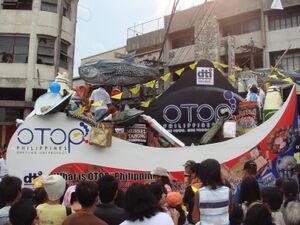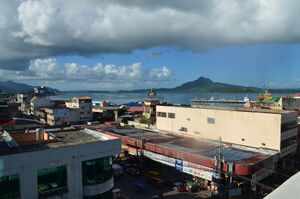بيسايا الشرقية
Eastern Visayas (Region VIII)
Sinirangan Kabisay-an Sidlakang Kabisay-an Silangang Kabisayaan Region VIII | |
|---|---|
| الإحداثيات: 11°14′N 125°03′E / 11.233°N 125.050°E | |
| Country | |
| Island group | Visayas |
| Regional center and largest city | Tacloban |
| المساحة | |
| • الإجمالي | 23٬251٫1٬058;//data.marefa.org/entity/Q91٬546 كم² (Formatting error: invalid input when rounding ميل²) |
| أعلى منسوب (Alto Peak) | 1٬325 m (4٬347 ft) |
| التعداد (خطأ: زمن غير صحيح. تعداد السكان)[1] | |
| • الإجمالي | 655٬159، 977٬525، 1٬462٬159، 1٬764٬103، 2٬040٬966، 2٬381٬409، 2٬599٬728، 2٬799٬534، 3٬054٬490، 3٬366٬917، 3٬610٬355، 3٬915٬140، 4٬101٬322، 4٬440٬150، 4٬547٬150 |
| منطقة التوقيت | UTC+8 (PST) |
| ISO 3166 code | PH-08 |
| Provinces | |
| Cities | |
| Municipalities | 136 |
| Barangays | 4,390 |
| Cong. districts | 12 |
| Languages |
|
| GDP (2021) | ₱450 billion $9 billion[2] |
| Growth rate | ▲ (6%)[2] |
| HDI | ▲ 0.697 (Medium) |
| HDI rank | 11th in Philippines (2019) |
Eastern Visayas (واراي-واراي: [Sinirangan Kabisay-an] Error: {{Lang}}: text has italic markup (help); سبوانو: Sidlakang Kabisay-an; تگالوگ: Silangang Kabisayaan or Silangang Visayas) is an administrative region in the Philippines, designated as Region VIII. It consists of three main islands, Samar, Leyte and Biliran. The region has six provinces, one independent city and one highly urbanized city[3] namely, Biliran, Leyte, Northern Samar, Samar, Eastern Samar, Southern Leyte, Ormoc and Tacloban. The highly urbanized city of Tacloban is the sole regional center. These provinces and cities occupy the easternmost islands of the Visayas group of islands.
Eastern Visayas faces the Philippine Sea to the east. The region's most famous landmark is the San Juanico Bridge, which links the provinces of Samar and Leyte. As of 2020, the Eastern Visayas region has a population of 4,547,150 inhabitants,[1] making it the third most populous region in the Visayas.
Etymology
The current name of the region was derived from its location in the easternmost part of the Visayas.
الجغرافيا
|
Widespread deforestation of the Visayas due to Typhoon Haiyan |
Eastern Visayas lies on the east central section of the Philippine archipelago. It consists of three main islands, Leyte, Biliran and Samar, which form the easternmost coasts of the archipelago. It is bounded on the east and north by the Philippine Sea with the San Bernardino Strait separating Samar from southeastern Luzon; on the west by the Camotes and Visayan seas, and on the south by the Bohol Sea with the Surigao Strait separating Leyte from northwestern Mindanao. It has a total land area of 2,156,285 hectares (5,328,300 acres) or 7.2% of the country's total land area.[4] 52% of its total land area are classified as forestland and 48% as alienable and disposable land.
المناخ
There are two types of climate prevailing in the region under the Corona system of classification: Type II and Type IV. Type II climate is characterized by having no dry season but a pronounced maximum rainfall from November to January. Samar Island and the eastern part of Leyte Island fall under this type of climate. Type IV on the other hand has an even distribution of rainfall the year round and a short period of dry season that can be observed starting February up to May. This type of climate is well exhibited at the western half of Leyte island and some portion of Samar which covers the municipality of Motiong up to San Isidro of Northern Samar.
In November 2013, the region was struck with the highest death toll in the nation by Super Typhoon Haiyan, the second deadliest typhoon ever to violently hit the Philippines. Typhoons frequently hit the region along with the Bicol region as the most typhoon prone parts of the Philippines.
المصادر الطبيعية
The region's sea and inland waters are rich sources of salt and fresh water fish and other marine products. It is one of the fish exporting regions of the country. There are substantial forest reserves in the interiors of the islands. Its mineral deposits include chromite, uranium (in Samar), gold, silver, manganese, magnesium, bronze, nickel, clay, coal, limestone, pyrite and sand and gravel. It has abundant geothermal energy and water resources to support the needs of medium and heavy industries.
Administrative divisions
Provinces
Eastern Visayas consists of 6 provinces, 1 highly urbanized city, 1 independent component city, 5 component cities, 136 municipalities and 4,390 barangays.
| Province or HUC | Capital | Population (2015)[1] | Area[5] | Density | Cities | Muni. | Barangay | |||||
|---|---|---|---|---|---|---|---|---|---|---|---|---|
| km2 | sq mi | /km2 | /sq mi | |||||||||
| Biliran | Naval | 3٫9% | 171٬612 | 536.01 | 206.95 | 320 | 830 | 0 | 8 | 132 | ||
| Eastern Samar | Borongan | 10٫5% | 467٬160 | 4,617.16 | 1,782.70 | 100 | 260 | 1 | 22 | 597 | ||
| Leyte | Tacloban | 38٫8% | 1٬724٬679 | 6,335.44 | 2,446.13 | 270 | 700 | 3 | 40 | 1,503 | ||
| Northern Samar | Catarman | 14٫2% | 632٬379 | 3,694.96 | 1,426.63 | 170 | 440 | 0 | 24 | 569 | ||
| Samar | Catbalogan | 17٫6% | 780٬481 | 6,048.03 | 2,335.16 | 130 | 340 | 2 | 24 | 951 | ||
| Southern Leyte | Maasin | 9٫5% | 421٬750 | 1,801.46 | 695.55 | 230 | 600 | 1 | 18 | 500 | ||
| Tacloban | † | — | 5٫5% | 242٬089 | 201.72 | 77.88 | [convert: invalid number] | — | — | 138 | ||
| Total | 4,440,150 | 23,234.78 | 8,971.00 | 190 | 490 | 7 | 136 | 4,390 | ||||
|
† Tacloban is a highly-urbanized city; figures are excluded from Leyte province.
| ||||||||||||
Governors and vice governors
| Province | Image | Governor | Political Party | Vice Governor | |
|---|---|---|---|---|---|

|
Gerard Roger Espina | Nacionalista | Brigido Caneja III | ||

|
Ben Evardone | PDP–Laban | Maria Caridad Goteesan | ||

|
Jericho Petilla | PDP–Laban | Leonardo Javier Jr. | ||

|
Edwin Ongchuan | NUP | Clarence Dato | ||

|
Sharee Ann Tan | Nacionalista | Arnold Vasquez Tan | ||

|
Damian Mercado | PDP–Laban | Rosa Emilia Mercado | ||
Cities
- † Regional center
| City | Population (2015)[1] | Area[6] | Density | City class | Income class | Founding year | Province | ||
|---|---|---|---|---|---|---|---|---|---|
| Baybay | 109,432 | 459.34 | 177.35 | 240 | 620 | Component | 4th | 1620 (cityhood: 2007) | Leyte |
| Borongan | 69,297 | 475.00 | 183.40 | 150 | 390 | Component | 5th | 1619 (cityhood: 2007) | Eastern Samar |
| Calbayog | 183,851 | 880.74 | 340.06 | 210 | 540 | Component | 1st | 1785 (cityhood: 1948) | Samar |
| Catbalogan | 103,879 | 274.22 | 105.88 | 380 | 980 | Component | 5th | 1596 (cityhood: 2007) | Samar |
| Maasin | 85,560 | 211.71 | 81.74 | 400 | 1,000 | Component | 4th | 1770 (cityhood: 2000) | Southern Leyte |
| Ormoc | 215,031 | 613.60 | 236.91 | 350 | 910 | Independent component | 1st | 1834 (cityhood: 1947) | Leyte |
| † Tacloban | 242,089 | 201.72 | 77.88 | [convert: invalid number] | Highly urbanized | 1st | 1770 (cityhood: 1953) | Leyte | |
Demographics
|
| ||||||
| Source: Philippine Statistics Authority[1][7] | |||||||
Languages
The native languages of Eastern Visayas are:
- Abaknon, spoken in Capul Island in Northern Samar.
- Baybayanon, spoken in Baybay in Leyte.
- Boholano, spoken in Southern Leyte.
- Cebuano, spoken in parts of Biliran, Leyte, Southern Leyte, Samar, Northern Samar, and Eastern Samar. It is the main lingua franca of those areas.
- Kinabalian, spoken in the municipality of San Juan, Southern Leyte.
- Waray-Waray, spoken in Biliran, Leyte, Southern Leyte, Samar, Northern Samar, and Eastern Samar. It is the regional lingua franca.
Economy
Poverty incidence of بيسايا الشرقية
|
Eastern Visayas is primarily an agricultural region with rice, corn, coconut, sugarcane and banana as its major crops.
Primary sources of revenue are manufacturing, wholesale and retail trade and services. Mining, farming, fishing and tourism contribute significantly to the economy. Manufacturing firms include mining companies, fertilizer plants, sugar central, rice and corn mills and other food processing plants. Tacloban is the hub of investment, trade and development in the region.
Other industries include coconut oil extraction, alcohol distilling, beverage manufacture and forest products. Home industries include hat and basket weaving, metal craft, needlecraft, pottery, ceramics, woodcraft, shell craft and bamboo craft.
Culture
Dances
Tinikling, the Philippines' national dance is folkdance that originated from the region. But the most popular cultural dance among Waraynons is the Kuratsa, danced during feast celebrations and special gatherings. The Leyte Kalipayan Dance Company, a local cultural group, held highly successful performances around the world.
Music
Waray people are music lovers whose folkloric music are mostly ballads in form, famous of which is Iroy nga Tuna (Motherland), a patriotic song.
Festivals
Since 2018, Eastern Visayas holds each October the 'Oktubafest' to showcase the best local wine made from coconut palm called tuba.[9][10]
Infrastructure
Transportation
The region's Leyte and Samar islands serve as main link between Luzon and Mindanao by land transport. A total of nine airports, are strategically located in different parts of the six provinces that define the region. Daniel Z. Romualdez Airport in Tacloban is the main gateway by air to the region. There are seaports in Tacloban, Baybay, Catbalogan, Calbayog, Borongan, Allen, Ormoc, Bato, Hilongos, Maasin, Sogod, and Naval.
Power and energy
The region is the top producer of geothermal energy supply in the country. The province of Leyte hosts the biggest geothermal plant in the Philippines. Still, geothermal exploration is ongoing in the nearby province of Biliran. With abundance of river system, the region has potential in hydroelectric production. The strait of San Juanico between Leyte and Samar islands has been declared as potential source for water current and tidal energy sources.
Education
Eastern Visayas is home to several state universities, including the prestigious University of the Philippines Visayas Tacloban College. The region is also home to the University of Eastern Philippines (UEP), located in Catarman, Northern Samar, which holds the most number of baccalaureate and post-baccalaureate courses among universities in the region.
The Zonal Agricultural University for the Visayas under the National Agriculture Education System concept, Visayas State University (VSU) is also in the region, located in Baybay. Also, the region is home to Palompon Institute of Technology, a maritime school in the Philippines providing deck and engine cadet. Its main campus is located in the municipality of Palompon, Leyte province.
The Eastern Visayas State University is Leyte's state university with five extension campuses. Southern Leyte State University with five extension campuses, is the only state university in the province of Southern Leyte. In Biliran, Naval State University is the province state university. For Eastern Samar, the Eastern Samar State University is the only state university of the province with four extension campus while Samar State University is Samar's state university with two extension campuses. Northwest Samar State University serves Samar Province's first district. For teacher education, the Leyte Normal University specializes in education courses.
References
- ^ أ ب ت ث ج
Census of Population (2015). Highlights of the Philippine Population 2015 Census of Population. PSA. Retrieved 20 يونيو 2016.
{{cite encyclopedia}}: Cite has empty unknown parameter:|chapterurl=(help)CS1 maint: numeric names: authors list (link) - ^ أ ب "Gross Regional Domestic Product". openstat.psa.gov.ph. Philippine Statistics Authority. Retrieved May 20, 2021.
- ^ "Eastern Visayas in Visayas Philippines". Archived from the original on November 26, 2012. Retrieved December 1, 2012.
- ^ "Evis.net.ph - evis Resources and Information".
- ^ "PSGC Interactive; List of Provinces". Philippine Statistics Authority. Archived from the original on January 17, 2013. Retrieved March 29, 2016.
- ^ "PSGC Interactive; List of Cities". Philippine Statistics Authority. Archived from the original on April 29, 2011. Retrieved March 29, 2016.
- ^ "Population and Annual Growth Rates for The Philippines and Its Regions, Provinces, and Highly Urbanized Cities" (PDF). 2010 Census and Housing Population. Philippine Statistics Authority. Archived from the original (PDF) on September 28, 2013. Retrieved August 10, 2013.
- ^ "Poverty incidence (PI):". Philippine Statistics Authority. Retrieved December 28, 2020.
- ^ "Oktubafest staging part of the 75th Leyte Gulf Landings anniversary". September 24, 2019.
- ^ "Eastern Visayas to stage best coco wine in 'Oktubafest'". Philippine News Agency.
External links
 Media related to بيسايا الشرقية at Wikimedia Commons
Media related to بيسايا الشرقية at Wikimedia Commons بيسايا الشرقية travel guide from Wikivoyage
بيسايا الشرقية travel guide from Wikivoyage Geographic data related to بيسايا الشرقية at OpenStreetMap
Geographic data related to بيسايا الشرقية at OpenStreetMap
- Pages using gadget WikiMiniAtlas
- CS1 maint: numeric names: authors list
- Short description is different from Wikidata
- Pages using multiple image with auto scaled images
- Coordinates on Wikidata
- Pages using infobox settlement with image map1 but not image map
- Lang and lang-xx template errors
- Articles containing سبوانو-language text
- Pages using Lang-xx templates
- Articles containing تگالوگ-language text
- Convert errors
- Eastern Visayas
- Regions of the Philippines
- Visayas
- صفحات مع الخرائط


